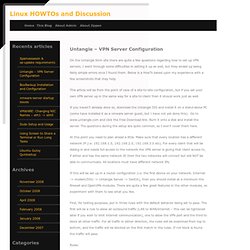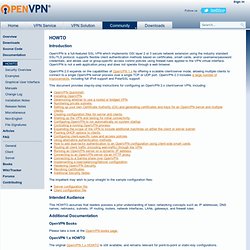

The Golden Ear - Creating Certificates and Keys For pfSense 1.2 Series OpenVPN Servers and Clients. Client Certificates and Keys Create a client certificate and key for each user Export the Client Certificate and Key and CA Certificate (Optional) Export the client certificate and key and CA certificate in .PEM format - if you want to use from NetworkManager or command-line Export the client certificate in .PEM format Export the client key in .PEM format Export the CA certificate in .PEM format (Optional) Export the client certificate and key and CA certificate in .P12 format - if you want to use from the command-line Notable changes to this document 21 February 2012 - Changed client certificate keylength from 1024 to 4096, and I'm questioning whether the certificate authority and server certificate should do the same. 2 February 2011 - Added 'Further Certificate and Key Operations' section with 'Renewing Certificates'. 1.0 Introduction 2.0 TinyCA tinyca (tinyca.sm-zone.net) is a very simple Certification Authority.

In Debian or Ubuntu install the package 'tinyca'. Run TinyCA. See also. Welcome to The Fusion Network. VPN connects but no resource access - Untangle Forums. Untangle – VPN Server Configuration : Linux HOWTOs and Discussion. On the Untangle form site there are quite a few questions regarding how to set up VPN servers.

I went through some difficulties in setting it up as well, but they ended up being fairly simple errors once I found them. Below is a HowTo based upon my experience with a few screenshots that may help. This article will be from the point of view of a site-to-site configuration, but if you set your own VPN server up in the same way for a site-to-client then it should work just as well. If you haven’t already done so, download the Untangle ISO and install it on a stand-alone PC (some have installed it as a vmware server guest, but I have not yet done this). Go to www.untangle.com and click the Free Download link. At this point you need to plan ahead a little. If this will be set up in a router configuration (i.e. the first device on your network. First, for testing purposes, put in three rules with the default behavior being set to pass.
Rules: Pass – ANY – VPN – any - any – any – any. Success! I've successfully gotten OpenVPN + PAM + FreeRADIUS authenticating!! Site to Site VPN step by step instructions - Untangle Forums. OpenVPN client on DD-WRT - Untangle Forums. OpenVPN - UntangleWiki. From UntangleWiki OpenVPNOpenVPN#StatusOpenVPN#ServerOpenVPN#ClientOpenVPN#Event_Log About OpenVPN OpenVPN enables you to create an SSL-based VPN (virtual private network) that supports both site-to-site and client-to-site tunnels.

This allows your road warrior users to connect to local resources as if they were in the office, or connect the networks of several geographically distant offices together - all with the added security of encryption protecting your data. OpenVPN supports any operating system with an OpenVPN-compatible VPN client (which is almost every OS), even smartphones! The OpenVPN application can run as a server allowing for remote client to connect to the Untangle server, and the OpenVPN application can connect to other remote Untangle servers as a client. Settings This section reviews the different settings and configuration options available for OpenVPN.
Status The Status tab shows you a list of open connections, the time the tunnels were created and transmit statistics. Yes. Live USB With OpenVPN - Untangle Forums. HowTO: Setup openvpn with LDAP integration on Pfsense 1.2.3. HOWTO. Introduction OpenVPN is a full-featured SSL VPN which implements OSI layer 2 or 3 secure network extension using the industry standard SSL/TLS protocol, supports flexible client authentication methods based on certificates, smart cards, and/or username/password credentials, and allows user or group-specific access control policies using firewall rules applied to the VPN virtual interface.

OpenVPN is not a web application proxy and does not operate through a web browser. OpenVPN 2.0 expands on the capabilities of OpenVPN 1.x by offering a scalable client/server mode, allowing multiple clients to connect to a single OpenVPN server process over a single TCP or UDP port. OpenVPN 2.3 includes a large number of improvements, including full IPv6 support and PolarSSL support.
This document provides step-by-step instructions for configuring an OpenVPN 2.x client/server VPN, including: The impatient may wish to jump straight to the sample configuration files: Intended Audience Additional Documentation. FAQ Community. Custom OpenVPN configuration - Untangle Forums. Configuration - openvpn-auth-ldap - Configuring the OpenVPN Auth-LDAP Plugin - Project Hosting on Google Code.
Access Server Downloads.